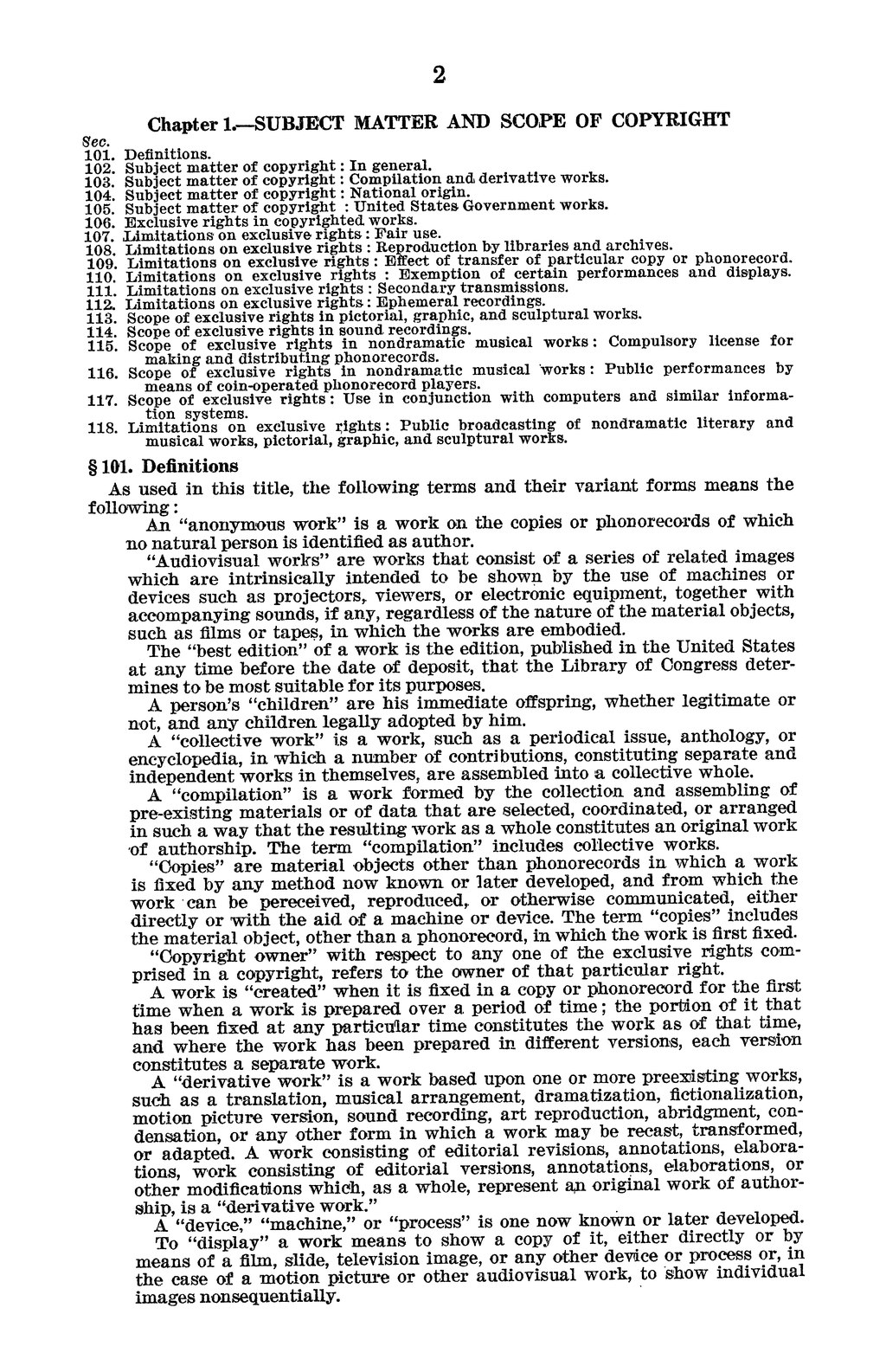This page has been validated.
2
Chapter 1.—SUBJECT MATTER AND SCOPE OF COPYRIGHT
Sec.
- Definitions.
- Subject matter of copyright: In general.
- Subject matter of copyright: Compilations and derivative works.
- Subject matter of copyright: National origin.
- Subject matter of copyright: United States Government works.
- Exclusive rights in copyrighted works.
- Limitations on exclusive rights: Fair use.
- Limitations on exclusive rights: Reproduction by libraries and archives.
- Limitations on exclusive rights: Effect of transfer of particular copy or phonorecord.
- Limitations on exclusive rights: Exemption of certain performances and displays.
- Limitations on exclusive rights: Secondary transmissions.
- Limitations on exclusive rights: Ephemeral recordings.
- Scope of exclusive rights in pictorial, graphic, and sculptural works.
- Scope of exclusive rights in sound recordings.
- Scope of exclusive rights in nondramatic musical works: Compulsory license for making and distributing phonorecords.
- Scope of exclusive rights in nondramatic musical works: Public performances by means of coin-operated phonorecord players.
- Scope of exclusive rights: Use in conjunction with computers and similar information systems.
- Limitations of exclusive rights: Public broadcasting of nondramatic literary and musical works, pictorial, graphic, and sculptural works.
§ 101. Definitions
As used in this title, the following terms and their variant forms mean the following:
- An “anonymous work” is a work on the copies or phonorecords of which no natural person is identified as author.
- “Audiovisual works” are works that consist of a series of related images which are intrinsically intended to be shown by the use of machines or devices such as projectors, viewers, or electronic equipment, together with accompanying sounds, if any, regardless of the nature of the material objects, such as films or tapes, in which the works are embodied.
- The “best edition” of a work is the edition, published in the United States at any time before the date of deposit, that the Library of Congress determines to be most suitable for its purposes.
- A person’s “children” are his immediate offspring, whether legitimate or not, and any children legally adopted by him. :A “collective work” is a work, such as a periodical issue, anthology, or encyclopedia, in which a number of contributions, constituting separate and independent works in themselves, are assembled into a collective whole.
- A “compilation” is a work formed by the collection and assembling of pre-existing materials or of data that are selected, coordinated, or arranged in such a way that the resulting work as a whole constitutes an original work of authorship. The term “compilation” includes collective works.
- “Copies” are material objects, other than phonorecords, in which a work is fixed by any method now known or later developed, and from which the work can be perceived, reproduced, or otherwise communicated, either directly or with the aid of a machine or device. The term “copies” includes the material object, other than a phonorecord, in which the work is first fixed.
- “Copyright owner” with respect to any one of the exclusive rights comprised in a copyright, refers to the owner of that particular right.
- A work is “created” when it is fixed in a copy or phonorecord for the first time; where a work is prepared over a period of time, the portion of it that has been fixed at any particular time constitutes the work as of that time, and where the work has been prepared in different versions, each version constitutes a separate work.
- A “derivative work” is a work based upon one or more pre-existing works, such as a translation, musical arrangement, dramatization, fictionalization, motion picture version, sound recording, art reproduction, abridgement, condensation, or any other form in which a work may be recast, transformed, or adapted. A work consisting of editorial revisions, annotations, elaborations, or other modifications which, as a whole, represent an original work of authorship, is a “derivative work.”
- A “device,” “machine,” or “process” is one now known or later developed.
- To “display” a work means to show a copy of it, either directly or by means of a film, slide, television image, or any other device or process or, in the case of a motion picture or other audiovisual work, to show individual images nonsequentially.
